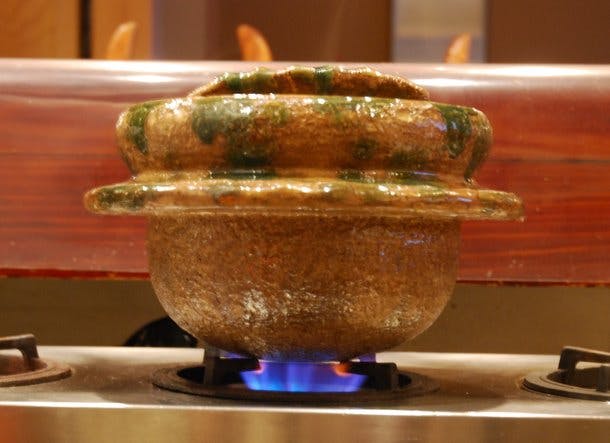
Cooking Rice in a Donabe
To the eminent Kyoto chef Nakahigashi-san, the preparation of a bowl of rice the traditional way is the embodiment of Japanese cuisine. In this article, he explains his process of preparing rice in a traditional donabe, sharing his expertise and techniques, as well as discussing the significance of rice in Japanese gastronomy.
I'm learning that to a Japanese chef, the humble act of preparing a bowl of rice the traditional way tells you everything you need to know about this cuisine (please see my post on the subject). To the eminent Kyoto chef Nakahigashi-san, who I've had the great fortune to interview, rice -- the last course served -- is the very point of his meal. All his other amazing dishes are simply way-stations along the gustatory journey.
Nakahigashi-san prepares his rice in a beautiful, traditional donabe, a thick earthenware vessel he has handmade especially for his restaurant. He heats it in an okudo-san, a traditional Japanese oven. Tasting the rice that he cooks is truly a transformative event. And not just for a curious foreigner like me: I can't forget the faces of his Japanese customers, sitting with me along the dining counter, savoring each steaming, sublime grain, and asking for more.
The day after I traveled to Iga to learn about donabe are made (please see my post), I visited Nakahigashi-san in Kyoto to ask him how to cook with one. He graciously paused his dinner preparations to instruct me.
To demonstrate what I could accomplish at home, Nakahigashi-san placed his donabe on a gas burner, rather than in the okudo-san. A good donabe can take direct heat. He added a cup of rice, already washed and rested, plus a cup of pure, spring-fed well water -- Nakashigashi-san has his own well at the restaurant.
(To wash and rest rice: Place rice in a bowl and fill with water. Swirl quickly and drain -- you don't want rice sitting in this milk-colored water. Then fill the bowl with more water and gently polish the rice with a hand motion like you're kneading bread dough. Drain and repeat until the water is clear (or almost clear, it never becomes perfectly translucent). Once washed, drain and rest rice for 30 minutes in a colander. Scoop a cup of this rehydrated rice to cook in the donabe.)
(By the way, Nakahigashi-san doesn't use any old rice, as you can imagine. His is locally grown by a farmer he knows and dried for three months. Back home I suggest you use California-grown, Japanese-style short grain rice, which is excellent.)
Placing an earthenware lid on top of the donabe, Nakahigashi-san turned on the flame to medium-high heat (see the photo above). After about ten minutes, bubbles and foam began to seep out from under the lid -- it's not an airtight fit. In fact, Nakahigashi-san lifted the lid to look inside, which surprised me because I was taught to keep the lid sealed at all times when steaming rice. So much for that orthodoxy. "Keep the same heat until the bubbling stops," the chef said.
The chef stood over the donabe watching it cook. At this point I began to smell the nutty, sublime fragrance of the rice rising from the donabe. After about ten minutes the bubbling stopped. Nakahigashi-san dropped the flame to very low and set a timer for another ten minutes. When the timer buzzes, you turn off the heat, he told me.
But six minutes into that ten minute period he lifted the lid of the donabe again -- oh, sacrilege! -- and spooned some rice into a porcelain bowl. "Here, taste this," he said, passing me the bowl. This was miebara style rice, he explained -- the grains more al dente than is typical for Japanese rice. I didn't realize that rice can be cooked to varying degrees of doneness in Japan.
After ten minutes the chef turned off the heat and lifted the lid of the donabe -- once again -- to peek inside. "It's ready, it doesn't have to rest," he said, and served me another bowl. This time the bright-white grains were softer and more delicate, and tasted and smelled as remarkable as the first time I tried Nakahigashi-san's rice. The chef scrapped off a piece of okoge for me, the caramelized crust of rice that forms along the walls of the donabe, a delicacy created only by an earthenware vessel. I thought how with a donabe and little patience you could tap into the very essence of Japanese cuisine in your own home -- a gift no computerized electric rice cooker, no matter how fancy, can ever bestow. Thank you, Nakahigashi-san.
UPDATE: A reader named Janet asked me about the shape of this traditional rice cooking pot. I posed the question to Chef Ono at Matsuri Restaurant in New York, who explained that the roundish bowl-shape of a traditional rice cooking pot has a two-fold purpose: first it allows steam to circulate inside the pot, and second, it allows the fire that's heating the pot to flow evenly around the vessel. The lid fits inside the bowl, which helps the liquid circulate inside the pot, and the little hole in the lid allows excess steam to escape. Finally, the lip around the outside of a traditional rice pot helps it fit snugly in a kamado, a traditional oven (Like Nakahigashi-san's okudo-san).
